
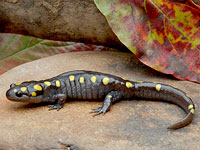
Photos: Top © Kim Hosen, Lower © John White |
Spotted Salamander
Ambystoma maculatum
<249mm (<10in)
A ‘mole salamander', stays underground most of the time. Usually only seen when coming out in early spring (Feb.-Mar.) after warm rains to congregate (often in large numbers with the males arriving a day or 2 earlier) in vernal pools to breed.
Our largest local salamander, dark, usually with 2 irregular rows of a variable number of yellowish, round spots. Gray belly.
Eggs are in globular, firm masses (starting white or clear before algae covers them) of 200 or so and attached to underwater objects. Egg masses are roughly the size of a tennis ball and hold their shape out of water. Eggs hatch in less than 2 months and the gilled larvae transform by July in most cases. A drying pool may cause them to metamorphose faster but they can also occasionally overwinter in permanent fishless ponds. |
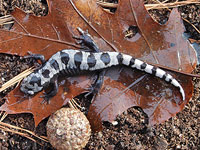
Photos © John White
|
Marbled Salamander
Ambystoma opacum
<127mm (<5in)
A stocky ‘mole salamander', stays underground most of the time. Light bands on shiny dark background. Markings tend to be gray in females, white in males. Belly black.
Breeds in the fall. Females lay about 100 eggs in depressions and guards them till the nest fills with water causing them to hatch. This early start may give them an advantage over other amphibians that may use the same pools in spring and are then prey items. |
|
Northern Dusky Salamander
Desmognathus fuscus
<141mm (<5.5in)
Color highly variable and changes with age. Young tend to have 5-8 pairs of yellowish spots on a grayish brown background. Older individuals may have much less of a pattern and the spots can fade. May have a wavy stripe on each side.
Diagonal light line from behind eye to angle/corner of jaw but this may fade as the animal gets older. Tail keeled and laterally compressed, triangular in cross section. Hind legs slightly larger than front legs. 13-15 costal grooves. Very good jumpers in efforts to get away.
Lungless, it breathes through its skin and mouth lining. Breeding is in late spring and eggs laid near water where the female stays with them till they hatch. |
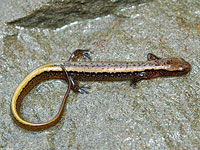
Photo © John White
More photos... |
Northern Two-lined Salamander
Eurycea bislineata
<121mm (<5in)
A brook salamander often found in and near streams. Yellow to reddish orange dorsally, peppered with dark dots. 2 dark lines run down back. Belly is yellow to reddish orange also. 14-16 costal grooves.
Breeding happens in the fall and eggs are laid on the underside of submerged rocks or logs, usually in moving water. The female often stays with the eggs till they hatch. Common. |
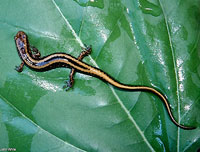
Photo © John White
|
Three-lined Salamander
Eurycea guttolineata
<200mm (<8in)
A brook salamander often found in and around streams, but may wander if area is moist. 3 dark stripes down back on an otherwise tan looking body. Long tail. Stripes may be more like rows of spots. Tan or yellow belly is mottled with gray. |
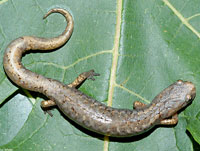
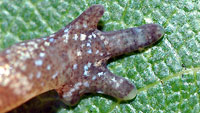
Photo © John White
|
Four-toed Salamander
Hemidactylium scutatum
<95mm <(3.5in)
Brown with scattered dark dots. Belly is white with black spots. Tail reddish and constricted near the base where it can easily break (but can be regenerated). It has 4 toes on each hind foot.
Usually found near bogs and habitats with moss. 30-50 eggs are laid under moss and guarded by the mother, often near many other female nests and in a hanging position. Larvae wriggle into the water and don't emerge for about 6 weeks as adults. |
Adult Newt

Eft Stage

Photo © John White
|
Eastern Newt
Notophthalmus viridescens
<140mm (<5.5in)
Adults are aquatic but breathe air. They vary in color from yellowish brown to dark green (usually olive green). Most have red spots on their backs that are surrounded in black. Their bellies are yellow with black spots.Their tails are flattened vertically to aid in swimming. Skin is not slimy and they lack clear costal (rib) grooves along their sides.
The 1-3 year subadult stages (efts) have thick, rough, reddish orange skin that allows them to live on land. This stage sometimes is skipped in some areas.
All stages are said to be distasteful to many predators and usually have at least a few red spots. Aquatic gilled larvae hatch from eggs (usually laid singly) on underwater plants (sometimes wrapped in a leaf). They transform within a year. |
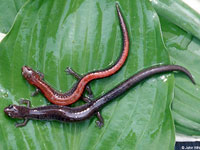
Photo © John White
|
Eastern Redback Salamander
Plethodon cinereus
<127mm (<5in)
Our most common salamander. Two color forms. There is no larval aquatic stage; complete development takes place inside the egg.
A lungless salamander, breathing through its skin and mouth lining. Red-backed form has a distinct reddish stripe down middle of back. Lead-backed form is a uniform dark gray or black. Belly is mottled in black and white (salt-and-peppered) in both phases.
Favorite food is termites and each sex may form territories to defend their food sources. Breed in the fall with female staying with eggs till they hatch (often under a log with the eggs hanging from the top by a jelly-like stalk). |

Photo © John White
|
White-spotted Slimy Salamander
Plethodon cylindraceus
<206mm (<8in)
Black salamander with variable sprinkling of white/cream spots on its back. Dark belly. Throat dark. Skin glands give off sticky slime when the animal is startled.
Eggs are laid in late summer or fall. There is no larval aquatic stage; complete development takes place inside the egg. A lungless salamander, breathing through its skin and mouth lining. Common. |
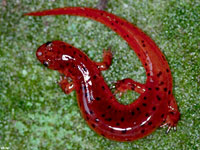
Photo © John White
|
Eastern Mud Salamander
Pseudotriton montanus montanus
<195mm (<8.2in)
Stocky with a small snout, short tail and brown eyes. 17 costal grooves. Back can be anywhere from pink to red to yellowish orange, with older individuals being darker and having indistinct pattern. Dark, circular spots are well separated.
Usually found in muddy areas. Eggs laid in late winter and females usually only breed every other year. Larvae may take 2 years to transform and then 3-4 years to mature.
A lungless salamander, breathing through its skin and mouth lining. Very uncommon in our area. |
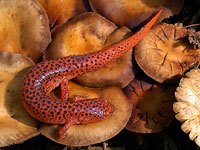
Photo © John White
|
Northern Red Salamander
Pseudotriton ruber ruber
<180mm (<7in)
Short tail and usually 16 costal grooves. Bright orange to red with lots of dark, irregular spots. Older animals darker with many spots fused together. Belly red with dark dots. Long snout and yellowish eyes.
Larvae take about 32 months to metamorphose. Lives near clear, cool streams or springs. Does not like mud or stagnant water. Uncommon. |